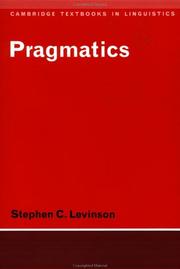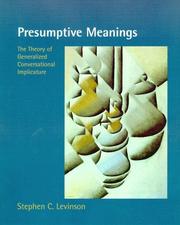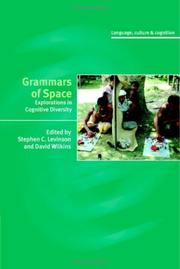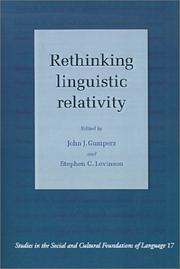| Listing 1 - 10 of 12 | << page >> |
Sort by
|

ISBN: 0521222354 0521294142 9780521222358 9780521294140 Year: 1985 Publisher: Cambridge : Cambridge university press,
Abstract | Keywords | Export | Availability | Bookmark
 Loading...
Loading...Choose an application
- Reference Manager
- EndNote
- RefWorks (Direct export to RefWorks)
Those aspects of language use that are crucial to an understanding of language as a system, and especially to an understanding of meaning, are the acknowledged concern of linguistic pragmatics. Yet until now much of the work in this field has not been easily accessible to the student, and was often written at an intimidating level of technicality. In this textbook, however, Dr Levinson has provided a lucid and integrative analysis of the central topics in pragmatics - deixis, implicature, presupposition, speech acts, and conversational structure. A central concern of the book is the relation between pragmatics and semantics, and Dr Levinson shows clearly how a pragmatic approach can resolve some of the problems semantics have been confronting and simplifying semantic analyses. The complexity of these issues is not disguised, but the exposition is always clear and supported by helpful exemplification. The detailed analyses of selected topics give the student a clear view of the empirical rigour demanded by the study of linguistic pragmatics, but Dr Levinson never loses sight of the rich diversity of the subject. An introduction and conclusion relate pragmatics to other fields in linguistics and other disciplines concerned with language usage - psychology, philosophy, anthropology and literature. Many students in these disciplines, as well as students of linguistics, will find this a valuable textbook.
Pragmatics. --- Pragmatics --- #SBIB:309H511 --- 801.56 --- Pragmalinguistics --- 801.56 Syntaxis. Semantiek --- Syntaxis. Semantiek --- Verbale communicatie: algemene pragmatiek, stilistiek en teksttheorie, discoursanalyse --- General semantics --- Language and languages --- Logic, Symbolic and mathematical --- Semantics (Philosophy) --- Philosophy --- #KVHA:Pragmatiek; Engels --- Philosophy of language --- Pragmatiek. --- Pragmatique --- Language and languages. --- Philosophy.

ISBN: 0262621304 9780262621304 0262122189 0262278251 0585272573 9780262278256 9780585272573 9780262122184 Year: 2000 Volume: *1 Publisher: Cambridge (Mass.): MIT Press,
Abstract | Keywords | Export | Availability | Bookmark
 Loading...
Loading...Choose an application
- Reference Manager
- EndNote
- RefWorks (Direct export to RefWorks)
Annotation
Pragmatics --- Grammaire comparée et générale --- Grammaire générale --- Grammaire générale et comparée --- Grammaire philosophique --- Grammaire universelle --- Grammar [Comparative and general ] --- Implicatie (Logica) --- Implication (Logic) --- Implication (Logique) --- Pragmatiek --- Pragmatique --- Semantics --- Semantiek --- Spraakkunst [Vergelijkende en algemene ] --- Sémantique --- Sémasiologie --- 801.56 --- Syntaxis. Semantiek --- Formal languages --- Grammar, Comparative and general. --- Pragmatics. --- Semantics. --- 801.56 Syntaxis. Semantiek --- Implication (Logic). --- #KVHA: Syntaxis --- #KVHA: Pragmatiek --- #KVHA: Communicatie --- Grammar, Comparative and general --- Formal semantics --- Semasiology --- Semiology (Semantics) --- Comparative linguistics --- Information theory --- Language and languages --- Lexicology --- Meaning (Psychology) --- Pragmalinguistics --- General semantics --- Logic, Symbolic and mathematical --- Semantics (Philosophy) --- Formal language semantics --- Logical semantics --- Semantics (Logic) --- Logic --- Comparative grammar --- Grammar --- Grammar, Philosophical --- Grammar, Universal --- Philosophical grammar --- Linguistics --- Philology --- Philosophy --- Grammar, Comparative
Book
ISBN: 3110733854 3110738473 Year: 2022 Publisher: Berlin/Boston : De Gruyter, Inc.,
Abstract | Keywords | Export | Availability | Bookmark
 Loading...
Loading...Choose an application
- Reference Manager
- EndNote
- RefWorks (Direct export to RefWorks)
This is a comprehensive description of a language spoken some 450 km offshore from the mainland of Papua New Guinea. The language is remarkable for its phonological, morphological and syntactic complexity. As the sole surviving member of its language family, and with little historical contact with surrounding languages, the language provides evidence of the kind of languages spoken in this part of the world before the Austronesian expansion. The grammar provides detailed information on the phoneme inventory, morphology, syntax and select semantic fields. Remarkable features include a 90 phoneme inventory including unique sounds, a morphology with thousands of non-compositional portmanteau elements, complex rules for negation, and extensive ergative syntax. Unusual patterns are also found in the organization of semantic fields, for example in partonymies of the body, taxonomies of the natural world, verbal semantics and kinship terms. The combination of linguistic 'rara' suggest that linguistic evolution under low contact can yield baroque and unusual patterns. The volume should be of special interest to linguists, typologists, sociolinguists, anthropologists and researchers in Oceania and Melanesia. Endorsement: "This long-awaited grammar is a major contribution to Papuan and general linguistics, providing as it does by far the most comprehensive and accurate grammatical description of a language that has already assumed a position as one of the world's most complicated. Hitherto, the most extensive grammatical description of the language has been the survey-like Henderson (1995), and while Levinson explicitly acknowledges his debt to this earlier grammar and to unpublished work by Henderson, his own detailed grammar clearly takes the level of description and analysis of the language to a completely new level. In particular, Levinson's grammar makes clear precisely to what extent and in what ways the language's morphology is complex beyond even what most studies on morphologically complex languages envisage. In addition, it provides a much more detailed account of the language's syntax, based on a judicious combination of corpus attestation and careful elicitation (incl. using the kits developed by Levinson's group at the MPI for Psycholinguistics). The grammar thus not only fills a major lacuna in our knowledge of the non-Austronesian languages of the New Guinea area, but also provides grist for future studies on the implications of the language's complexities."Bernard Comrie, University of California, Santa Barbara.
Book
Year: 2022 Publisher: Berlin : De Gruyter Mouton,
Abstract | Keywords | Export | Availability | Bookmark
 Loading...
Loading...Choose an application
- Reference Manager
- EndNote
- RefWorks (Direct export to RefWorks)
This is a comprehensive description of a language spoken some 450 km offshore from the mainland of Papua New Guinea. The language is remarkable for its phonological, morphological and syntactic complexity. As the sole surviving member of its language family, and with little historical contact with surrounding languages, the language provides evidence of the kind of languages spoken in this part of the world before the Austronesian expansion. The grammar provides detailed information on the phoneme inventory, morphology, syntax and select semantic fields. Remarkable features include a 90 phoneme inventory including unique sounds, a morphology with thousands of non-compositional portmanteau elements, complex rules for negation, and extensive ergative syntax. Unusual patterns are also found in the organization of semantic fields, for example in partonymies of the body, taxonomies of the natural world, verbal semantics and kinship terms. The combination of linguistic ?rara? suggest that linguistic evolution under low contact can yield baroque and unusual patterns. The volume should be of special interest to linguists, typologists, sociolinguists, anthropologists and researchers in Oceania and Melanesia. Endorsement: "This long-awaited grammar is a major contribution to Papuan and general linguistics, providing as it does by far the most comprehensive and accurate grammatical description of a language that has already assumed a position as one of the world's most complicated. Hitherto, the most extensive grammatical description of the language has been the survey-like Henderson (1995), and while Levinson explicitly acknowledges his debt to this earlier grammar and to unpublished work by Henderson, his own detailed grammar clearly takes the level of description and analysis of the language to a completely new level.
Book
ISBN: 3319056034 3319056026 Year: 2014 Publisher: Cham : Springer International Publishing : Imprint: Springer,
Abstract | Keywords | Export | Availability | Bookmark
 Loading...
Loading...Choose an application
- Reference Manager
- EndNote
- RefWorks (Direct export to RefWorks)
This Springer Brief examines the combination of computer vision techniques and machine learning algorithms necessary for humanoid robots to develop “true consciousness.” It illustrates the critical first step towards reaching “deep learning,” long considered the holy grail for machine learning scientists worldwide. Using the example of the iCub, a humanoid robot which learns to solve 3D mazes, the book explores the challenges to create a robot that can perceive its own surroundings. Rather than relying solely on human programming, the robot uses physical touch to develop a neural map of its environment and learns to change the environment for its own benefit. These techniques allow the iCub to accurately solve any maze, if a solution exists, within a few iterations. With clear analysis of the iCub experiments and its results, this Springer Brief is ideal for advanced level students, researchers and professionals focused on computer vision, AI and machine learning.
Robotics. --- Automation --- Machine theory --- Artificial intelligence. --- Computer vision. --- Computer science. --- Artificial Intelligence. --- Image Processing and Computer Vision. --- User Interfaces and Human Computer Interaction. --- Computer Imaging, Vision, Pattern Recognition and Graphics. --- Informatics --- Science --- Machine vision --- Vision, Computer --- Artificial intelligence --- Image processing --- Pattern recognition systems --- AI (Artificial intelligence) --- Artificial thinking --- Electronic brains --- Intellectronics --- Intelligence, Artificial --- Intelligent machines --- Machine intelligence --- Thinking, Artificial --- Bionics --- Cognitive science --- Digital computer simulation --- Electronic data processing --- Logic machines --- Self-organizing systems --- Simulation methods --- Fifth generation computers --- Neural computers --- Optical data processing. --- User interfaces (Computer systems). --- Interfaces, User (Computer systems) --- Human-machine systems --- Human-computer interaction --- Optical computing --- Visual data processing --- Integrated optics --- Photonics --- Computers --- Optical equipment --- User interfaces (Computer systems)
Book
ISBN: 3319056069 3319056050 Year: 2014 Publisher: Cham : Springer International Publishing : Imprint: Springer,
Abstract | Keywords | Export | Availability | Bookmark
 Loading...
Loading...Choose an application
- Reference Manager
- EndNote
- RefWorks (Direct export to RefWorks)
This SpringerBrief reveals the latest techniques in computer vision and machine learning on robots that are designed as accurate and efficient military snipers. Militaries around the world are investigating this technology to simplify the time, cost and safety measures necessary for training human snipers. These robots are developed by combining crucial aspects of computer science research areas including image processing, robotic kinematics and learning algorithms. The authors explain how a new humanoid robot, the iCub, uses high-speed cameras and computer vision algorithms to track the object that has been classified as a target. The robot adjusts its arm and the gun muzzle for maximum accuracy, due to a neural model that includes the parameters of its joint angles, the velocity of the bullet and the approximate distance of the target. A thorough literature review provides helpful context for the experiments. Of practical interest to military forces around the world, this brief is designed for professionals and researchers working in military robotics. It will also be useful for advanced level computer science students focused on computer vision, AI and machine learning issues.
Robotics --- Military robots. --- Military applications. --- Robotic soldiers --- Robots --- Military engineering --- Military robots --- Military applications --- Artificial intelligence. --- Computer vision. --- Computer science. --- Artificial Intelligence. --- Image Processing and Computer Vision. --- User Interfaces and Human Computer Interaction. --- Computer Imaging, Vision, Pattern Recognition and Graphics. --- Informatics --- Science --- Machine vision --- Vision, Computer --- Artificial intelligence --- Image processing --- Pattern recognition systems --- AI (Artificial intelligence) --- Artificial thinking --- Electronic brains --- Intellectronics --- Intelligence, Artificial --- Intelligent machines --- Machine intelligence --- Thinking, Artificial --- Bionics --- Cognitive science --- Digital computer simulation --- Electronic data processing --- Logic machines --- Machine theory --- Self-organizing systems --- Simulation methods --- Fifth generation computers --- Neural computers --- Optical data processing. --- User interfaces (Computer systems). --- Interfaces, User (Computer systems) --- Human-machine systems --- Human-computer interaction --- Optical computing --- Visual data processing --- Integrated optics --- Photonics --- Computers --- Optical equipment

ISBN: 9780521855839 9780521671781 0521671787 0521855837 9780511486753 9780511246722 0511246722 0511244576 9780511244575 0511245327 9780511245329 051124603X 9780511246036 0511486758 9786610702558 6610702551 1107166144 9781107166141 1280702559 9781280702556 0511322895 9780511322891 Year: 2006 Publisher: Cambridge, UK ; New York : Cambridge University Press,
Abstract | Keywords | Export | Availability | Bookmark
 Loading...
Loading...Choose an application
- Reference Manager
- EndNote
- RefWorks (Direct export to RefWorks)
Spatial language - that is, the way languages structure the spatial domain - is an important area of research, offering insights into one of the most central areas of human cognition. In this collection, a team of leading scholars review the spatial domain across a wide variety of languages. Contrary to existing assumptions, they show that there is great variation in the way space is conceptually structured across languages, thus substantiating the controversial question of how far the foundations of human cognition are innate. Grammars of Space is a supplement to the psychological information provided in its companion volume, Space in Language and Cognition. It represents a new kind of work in linguistics, 'Semantic Typology', which asks what are the semantic parameters used to structure particular semantic fields. Comprehensive and informative, it will be essential reading for those working on comparative linguistics, spatial cognition, and the interface between them.
Lexicology. Semantics --- Psycholinguistics --- Space and time in language. --- Psycholinguistics. --- Semantics. --- Semantics --- Space and time in language --- Language and languages --- Formal semantics --- Semasiology --- Semiology (Semantics) --- Comparative linguistics --- Information theory --- Lexicology --- Meaning (Psychology) --- Language, Psychology of --- Psychology of language --- Speech --- Linguistics --- Psychology --- Thought and thinking --- Psychological aspects --- Psycholinguistique --- Sémantique --- Arts and Humanities --- Language & Linguistics --- Espace et temps dans le langage

ISBN: 0521448905 9780521448901 Year: 1999 Volume: 17 Publisher: Cambridge: Cambridge university press,
Abstract | Keywords | Export | Availability | Bookmark
 Loading...
Loading...Choose an application
- Reference Manager
- EndNote
- RefWorks (Direct export to RefWorks)
Sapir-Whorf hypothesis. --- Thought and thinking. --- Language and culture --- Sapir-Whorf hypothesis --- Thought and thinking --- Mind --- Thinking --- Thoughts --- Educational psychology --- Philosophy --- Psychology --- Intellect --- Logic --- Perception --- Psycholinguistics --- Self --- Relativity (Linguistics) --- Whorf-Sapir hypothesis --- Anthropological linguistics --- Sociolinguistics --- Culture and language --- Culture --- Semiotic models --- Culture - Semiotic models
Book
ISBN: 2889198251 9782889198252 Year: 2016 Publisher: Frontiers Media SA
Abstract | Keywords | Export | Availability | Bookmark
 Loading...
Loading...Choose an application
- Reference Manager
- EndNote
- RefWorks (Direct export to RefWorks)
The core use of language is in face-to-face conversation. This is characterized by rapid turn-taking. This turn-taking poses a number central puzzles for the psychology of language. Consider, for example, that in large corpora the gap between turns is on the order of 100 to 300 ms, but the latencies involved in language production require minimally between 600 ms (for a single word) or 1500 ms (for as simple sentence). This implies that participants in conversation are predicting the ends of the incoming turn and preparing in advance. But how is this done? What aspects of this prediction are done when? What happens when the prediction is wrong? What stops participants coming in too early? If the system is running on prediction, why is there consistently a mode of 100 to 300 ms in response time? The timing puzzle raises further puzzles: it seems that comprehension must run parallel with the preparation for production, but it has been presumed that there are strict cognitive limitations on more than one central process running at a time. How is this bottleneck overcome? Far from being 'easy' as some psychologists have suggested, conversation may be one of the most demanding cognitive tasks in our everyday lives. Further questions naturally arise: how do children learn to master this demanding task, and what is the developmental trajectory in this domain? Research shows that aspects of turn-taking, such as its timing, are remarkably stable across languages and cultures, but the word order of languages varies enormously. How then does prediction of the incoming turn work when the verb (often the informational nugget in a clause) is at the end? Conversely, how can production work fast enough in languages that have the verb at the beginning, thereby requiring early planning of the whole clause? What happens when one changes modality, as in sign languages - with the loss of channel constraints is turn-taking much freer? And what about face-to-face communication amongst hearing individuals - do gestures, gaze, and other body behaviors facilitate turn-taking? One can also ask the phylogenetic question: how did such a system evolve? There seem to be parallels (analogies) in duetting bird species, and in a variety of monkey species, but there is little evidence of anything like this among the great apes. All this constitutes a neglected set of problems at the heart of the psychology of language and of the language sciences. This Research Topic contributes to advancing our understanding of these problems by summarizing recent work from psycholinguists, developmental psychologists, students of dialog and conversation analysis, linguists, phoneticians, and comparative ethologists.
Psycholinguistics. --- Sociolinguistics. --- Etiquette. --- Conversation. --- Pragmatics. --- Speech acts (Linguistics) --- Social interaction. --- Human interaction --- Interaction, Social --- Symbolic interaction --- Exchange theory (Sociology) --- Psychology --- Social psychology --- Pragmalinguistics --- General semantics --- Language and languages --- Logic, Symbolic and mathematical --- Semantics (Philosophy) --- Talking --- Colloquial language --- Etiquette --- Oral communication --- Ceremonies --- Condolence, Etiquette of --- Manners --- Politeness --- Usages --- Conduct of life --- Manners and customs --- Language and society --- Society and language --- Sociology of language --- Language and culture --- Linguistics --- Sociology --- Integrational linguistics (Oxford school) --- Language, Psychology of --- Psychology of language --- Speech --- Thought and thinking --- Illocutionary acts (Linguistics) --- Speech act theory (Linguistics) --- Speech events (Linguistics) --- Philosophy --- Social aspects --- Sociological aspects --- Psychological aspects --- face-to-face conversation --- psychology --- psychology of language --- psycholinguists --- turn-taking --- language sciences --- language --- Frontiers in Psychology --- Intonation (linguistics) --- Prosody (linguistics) --- Sign language --- Stroke --- Syntax --- Utterance
Book
ISBN: 9780262517751 0262517752 9780262305846 0262305844 0262517752 1282133829 9781282133822 9786613806406 6613806404 0262304929 9780262304924 Year: 2012 Publisher: Cambridge, MA ; London Mit Press
Abstract | Keywords | Export | Availability | Bookmark
 Loading...
Loading...Choose an application
- Reference Manager
- EndNote
- RefWorks (Direct export to RefWorks)
Psycholinguistics --- Philosophy of language --- Language and languages. --- Sapir-Whorf hypothesis. --- Relativity (Linguistics) --- Whorf-Sapir hypothesis --- Anthropological linguistics --- Sociolinguistics --- Foreign languages --- Languages --- Anthropology --- Communication --- Ethnology --- Information theory --- Meaning (Psychology) --- Philology --- Linguistics
| Listing 1 - 10 of 12 | << page >> |
Sort by
|

 Search
Search Feedback
Feedback About UniCat
About UniCat  Help
Help News
News